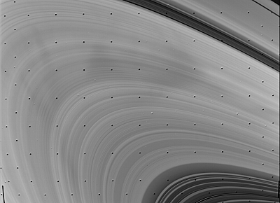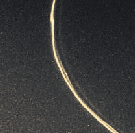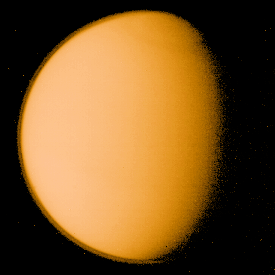|
Saturn,
the second most massive planet, and the most distant planet known to the
ancients, is one of the most beautiful sites in the Solar System, as witnessed
by the adjacent image. The most striking feature of Saturn is the spectacular
ring system. Although this feature is no longer unique, since we now know that all the
Gas Giant planets have rings, the rings of Saturn are much more elaborate than
those of any of the other planets. Saturn shares many features with its even
larger Gas Giant neighbor Jupiter, but has various unique features in its ownright.
General Features
 Saturn is the second most massive planet, and also the second largest in size.
It is a Gas Giant planet with a rotational period of 10-11 hours (depending on
latitude),
and an orbital period of 29.5 years.
The rapid rotation flattens Saturn at the poles by about 10%, making it the
most oblate planet. Its composition is similar to that of Jupiter, being
composed mostly of hydrogen and helium. Like Jupiter, it is mostly liquid,
with a small rocky core expected, but not directly observed, and like Jupiter,
it has an internal heat source (it radiates more energy than it receives)..
Saturn is the second most massive planet, and also the second largest in size.
It is a Gas Giant planet with a rotational period of 10-11 hours (depending on
latitude),
and an orbital period of 29.5 years.
The rapid rotation flattens Saturn at the poles by about 10%, making it the
most oblate planet. Its composition is similar to that of Jupiter, being
composed mostly of hydrogen and helium. Like Jupiter, it is mostly liquid,
with a small rocky core expected, but not directly observed, and like Jupiter,
it has an internal heat source (it radiates more energy than it receives)..
Saturn has the lowest density of any planet, 0.7
g/cc, which is less than that of water. Saturn is of such
low density that it would float in a (gigantic) bathtub. However, you would
not want to put Saturn in a bathtub. Do you know why?
Because it would leave a ring!
The interior is probably similar to Jupiter, with metallic hydrogen responsible
for the strong magnetic field of Saturn. The concentration of helium relative
to hydrogen is somewhat less than for Jupiter. This is thought to be due to
the colder temperature of Saturn.
Although the Hubble Space Telescope can now take very good images of Saturn,
our best information comes from space probes: Pioneer 11, Mariner 11
and 12, and Voyager I and II.
The Surface and The Interior
 The surface of Saturn bears many similarities with the surface of Jupiter, but
the color contrast is generally less. This is thought to be due to Saturn being
colder than Jupiter (further from the Sun), so it has different chemical
reactions in its atmosphere, leading to different coloration.
The surface of Saturn bears many similarities with the surface of Jupiter, but
the color contrast is generally less. This is thought to be due to Saturn being
colder than Jupiter (further from the Sun), so it has different chemical
reactions in its atmosphere, leading to different coloration.
There are large anticyclonic cells on the surface, apparently driven by the
planet's internal heat source, but none are as large as the Great Red Spot on
Jupiter, and they are not as abundant as on Jupiter. The image adjacent left
shows a red anticyclonic disturbance about the diameter of the Earth.
High-Velocity Winds
There are extremely high velocity winds in the atmosphere of Saturn. Unlike
the case for Jupiter, the variations in wind speeds are not strongly correlated
with the positions of the belts and bands. The wind speeds in the atmosphere
of Saturn have been measured to be as high as 1800 km/hr, which is about 4
times the highest speeds in the atmosphere of Jupiter.
The Interior of Saturn
Like Jupiter, Saturn is largely liquid. The slightly higher concentration of
helium relative to hydrogen in the atmosphere is thought to be be due to the
colder temperature of Saturn. Under these colder conditions, liquid helium
does not dissolve in liquid hydrogen and drops of helium sink to the center,
depleting the outer regions in helium. Speculation on Saturn's internal heat
source is similar to that for Jupiter.
The magnetic field of Saturn is similar
to that of Jupiter, but weaker. Electrical currents in liquid metallic
hydrogen deep in the interior are assumed to be the cause of the magnetic
field. Unlike the case for Jupiter, the magnetic field traps charged particles
in "Van Allen belts" rather than in sheets, and there appear to
be fewer trapped charged particles than is the case for Jupiter.
The Rings
 The ring system of Saturn is divided into 5 major components: the G, F, A, B, and C rings, listed from outside
to inside (but in reality, these major divisions are subdivided into thousands of individual ringlets).
The F and G rings are thin and difficult to see, while the A, B, and C rings are broad and
easily visible. The large gap between the A ring and and the B ring is called the Cassini division.
The ring system of Saturn is divided into 5 major components: the G, F, A, B, and C rings, listed from outside
to inside (but in reality, these major divisions are subdivided into thousands of individual ringlets).
The F and G rings are thin and difficult to see, while the A, B, and C rings are broad and
easily visible. The large gap between the A ring and and the B ring is called the Cassini division.
The adjacent image is a rare view of Saturn's rings seen just after the Sun has set below
the ring plane, taken with the Hubble Space Telescope on Nov. 21, 1995.
This perspective is unusual because the Earth is slightly above
and the Sun slightly below the rings. Normally we see the rings fully illuminated by the Sun.
Three bright ring features are seen: the F Ring, the Cassini
Division, and the C Ring (moving from the outer rings to the inner). The low
concentration of material in these rings allows light from the Sun to shine
through them. The A and B rings are much denser, which limits the amount of
light that penetrates through them. Instead, they are faintly visible because
they reflect light from Saturn's disk
(Ref).
Ring Structure and Composition
 High resolution photographs from the Voyager missions indicate that the rings of Saturn are composed of hundreds of
thousands of "ringlets", and that regions like the largest "gap" called the Cassini division, also contain fainter rings
(adjacent image). The rings cannot be solid, because they lie inside the
Roche limit.
They presumably represent either a satellite torn apart by tidal forces, or (more likely) material that
was never allowed to condense into moons because of the tidal forces.
The evidence indicates that the rings are composed of particles that are mostly ice crystals, with
sizes as large as centimeters or meters.
The total mass in the rings is about the size of a medium mass moon, and the
rings are only about 10 km thick.
High resolution photographs from the Voyager missions indicate that the rings of Saturn are composed of hundreds of
thousands of "ringlets", and that regions like the largest "gap" called the Cassini division, also contain fainter rings
(adjacent image). The rings cannot be solid, because they lie inside the
Roche limit.
They presumably represent either a satellite torn apart by tidal forces, or (more likely) material that
was never allowed to condense into moons because of the tidal forces.
The evidence indicates that the rings are composed of particles that are mostly ice crystals, with
sizes as large as centimeters or meters.
The total mass in the rings is about the size of a medium mass moon, and the
rings are only about 10 km thick.
Spokes and other Structure
 It was expected that collisions between ring particles would tend to make the
rings uniform, but Voyager I found changing structures in the radial direction
that are termed "spokes". Some of this structure is shown in the adjacent
animation. Here is a smoother and longer
movie of the same phenomenon. It is thought that
gravitational forces alone cannot account for the spoke structure, and it has
been proposed that electrostatic repulsion between ring particles may play a role.
It was expected that collisions between ring particles would tend to make the
rings uniform, but Voyager I found changing structures in the radial direction
that are termed "spokes". Some of this structure is shown in the adjacent
animation. Here is a smoother and longer
movie of the same phenomenon. It is thought that
gravitational forces alone cannot account for the spoke structure, and it has
been proposed that electrostatic repulsion between ring particles may play a role.
 The Voyagers found that the rings were not necessarily circular, and even found
rings that appeared to be braided (adjacent image). They found further that
the outer ring was kept in place by the gravitational interaction of two small
"shepherd moons"
lying just inside and outside it, and that at least some of the other
rings are kept narrow by similar small shepherding satellites. Generally,
although we have increased immensely our knowledge of the rings of Saturn over
the last 2 decades, we still do not fully understand their structure, dynamics, or origin.
The Voyagers found that the rings were not necessarily circular, and even found
rings that appeared to be braided (adjacent image). They found further that
the outer ring was kept in place by the gravitational interaction of two small
"shepherd moons"
lying just inside and outside it, and that at least some of the other
rings are kept narrow by similar small shepherding satellites. Generally,
although we have increased immensely our knowledge of the rings of Saturn over
the last 2 decades, we still do not fully understand their structure, dynamics, or origin.
The Moons
The following image shows a montage of 15 of Saturn's satellites (the current known number is 19).
These range in size from Titan, the second largest moon in the Solar System (Ganymede is the largest),
to small asteroid-like objects.

Titan, the Largest Moon of Saturn
 Titan has an atmosphere.
This can be seen faintly in the image on the left as an outline, and more clearly in the following image
Titan has an atmosphere.
This can be seen faintly in the image on the left as an outline, and more clearly in the following image

taken by Voyager looking back at Titan and showing sunlight scattering
in the atmosphere. The atmosphere of Titan has several layers of haze.
It has a pressure at the surface of 1.6 times that of Earth, and is
made up primarily of nitrogen, with about a 1% concentration of methane. The
temperature on the surface is very cold, about -180 degrees Celsius. The
atmosphere is extremely opaque because of thick smog that appears to result
from sunlight interacting with hydrocarbons, much as smog forms on the Earth.
The clouds are probably composed of liquid nitrogen and methane drops, and it
is speculated that Titan may be coverered with hydrocarbon lakes or oceans
(specifically, methane and ethane). Although many of the organic chemicals
thought to have been the precursors to life on Earth are present on
Titan, it appears to be too cold for life as we know it to have evolved there.
Here is a movie of infra-red images of Titan
made with the Hubble Space Telescape. The structure shown in this
animation represents heat variations in the atmosphere and surface of Titan.
Saturn's other Moons
Saturn's other moons have icy surfaces that are
very cold so that ice is as rigid as rock
and craters form from meteor impacts. The mean densities of these moons are
1.0 to 1.5 g/cc, implying that they are probably mostly ice, though they may
have some rocky consituents. Most of Saturns satellites (as for those of Jupiter) are
tidally locked
and keep the same face turned toward the planet as they orbit.

Rhea |

Iapetus |
The preceding images show the satellite Rhea, which is seen to have many impact craters, and
Iapetus, which has one side that is 10 times darker than the other. Other moons of Saturn include
Mimas,
which has an impact crater 1/4 the diameter of the moon,
Enceladus, which may be geologically active because of tidal heating by Saturn,
Tethys, which
has a large flattened crater that is 1/2 the diameter of the moon and avery large canyon, and
Dione, which
is heavily cratered with ray structures associated
with some craters.
Two small moons have been found to share Tethys's orbit,
and one small moon shares Dione's orbit. This sharing of orbits had not been
seen before the detailed investigation of Saturns
system. Hyperion
rotates chaotically because of the influence of Titan's gravity and a highly eccentric orbit.
The outermost satellite,
Phoebe, may be a captured asteroid.
Unusual Hubble View of Moons and Rings
 The adjacent 10 Hubble Space Telescope images capture several small moons
orbiting Saturn while the Earth was just above the ring plane
and the Sun below it.
Moving out from Saturn, the
visible rings are: the broad C Ring, the Cassini Division, and the narrow F Ring.
The adjacent 10 Hubble Space Telescope images capture several small moons
orbiting Saturn while the Earth was just above the ring plane
and the Sun below it.
Moving out from Saturn, the
visible rings are: the broad C Ring, the Cassini Division, and the narrow F Ring.
The first pair of images shows Dione, near the upper middle of the frames.
Two smaller moons, Pandora (the brighter one closer to Saturn) and Prometheus, appear as if they're touching the F Ring.
In the second frame, Mimas emerges from Saturn's shadow and appears to be chasing Prometheus.
In the second image pair, Mimas has moved towards the tip of the F Ring. Rhea,
another bright moon, has just emerged from behind Saturn. Prometheus, the closest moon to Saturn, has
rounded the F Ring's tip and is approaching the planet. The slightly larger moon Epimetheus has appeared.
The third image pair shows Epimetheus, as a tiny dot just beyond the tip of the F Ring. Prometheus is in the
lower right corner. An elongated clump or arc of debris in the F ring is seen as a slight brightening on the far
side of this thin ring.
In the fourth image pair, Epimetheus, in the lower right corner, streaks towards Saturn. The long ring arc can be seen in both frames.
The fifth image pair again captures Mimas, beyond the tip of the F Ring. The same ring arc is still visible.
In addition to the satellites, a pair of stars can be seen passing behind the rings, appearing to move towards
the lower left due to Saturn's motion across the sky.
The images were taken Nov. 21, 1995, with Wide Field Planetary Camera-2 of the
Hubble Space Telescope
(Ref).
Shepherd Moons
In various instances now we know that ring structures in the Jovian planets are
stabilized by small "shepherd moons" that orbit in or near the rings and
stabilize them by their gravitational influences. One such example is the
F-ring of Saturn, which is kept narrow by two small shepherd moons,
Prometheus and Pandora, as illustrated in the adjacent image (click the button for labels).
We shall find similar examples of shepherd moons for rings associated with other planets.
Although such shepherd satellites clearly play a significant role in ring
structures, we only partially understand the details of these roles.
| 

